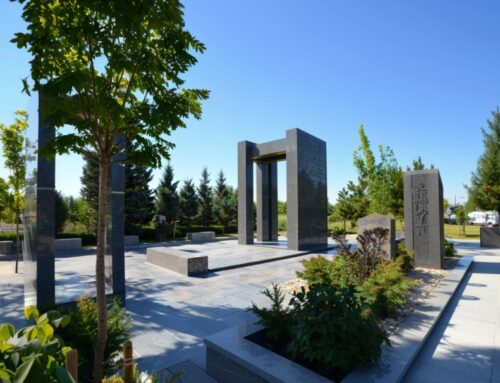The landscape of cemetery design and architecture has undergone remarkable transformations over centuries, reflecting changes in cultural attitudes, beliefs, and artistic expressions. From the earliest burial grounds to the serene and meticulously planned spaces we see today, each era brings a unique aesthetic and functional approach to the places where we honor and remember the departed. Among these evolutions, cemeteries in Saddle Brook, NJ, embody a blend of historical richness and contemporary values, offering peaceful sanctuaries for reflection and remembrance. As we delve into the fascinating journey of how cemetery design and architecture have evolved, join us in exploring the nuanced shifts that have shaped these sacred spaces into what they are today.
Tracing the Changes in Cemetery Architecture
Tracing the changes in cemetery architecture reveals a story of society’s evolving relationship with death and remembrance. Initially, burial grounds were simple, unmarked plots, often located on family land or in churchyards, reflecting a pragmatic approach to interment. As populations grew and urban centers expanded, the need for organized, communal spaces became apparent, giving rise to the first public cemeteries in the 19th century. These early cemeteries were designed as serene parks, with winding paths, lush landscaping, and ornate monuments. This park-like design not only responded to the practical needs of an increasing population but also reflected the Romantic era’s fascination with nature, beauty, and the sublime.
The turn of the 20th century introduced modernism to cemetery architecture, emphasizing functionality, simplicity, and a departure from the elaborate ornamentation of the past. The layout became more standardized, with geometric paths and uniform headstones providing a sense of equality and unity in death. Recent decades have seen a push towards sustainability and eco-consciousness, influencing the design of green burials and memorial parks that minimize environmental impact and return the body to the earth in a natural state. Each phase in the evolution of cemetery architecture mirrors the shifting values and philosophies of its time, offering a tangible reflection of how societies honor their dead.
How Cemetery Design Reflects Cultural Shifts
 How cemetery design reflects cultural shifts is evident through the alterations in landscapes, monuments, and practices over time. From the earliest burial sites to contemporary memorial parks, each embodies the prevailing beliefs, values, and aesthetics of its period. In ancient times, monumental tombs and elaborate burial mounds showcased respect for the deceased and belief in the afterlife, often reflecting societal hierarchies.
How cemetery design reflects cultural shifts is evident through the alterations in landscapes, monuments, and practices over time. From the earliest burial sites to contemporary memorial parks, each embodies the prevailing beliefs, values, and aesthetics of its period. In ancient times, monumental tombs and elaborate burial mounds showcased respect for the deceased and belief in the afterlife, often reflecting societal hierarchies.
As cultural attitudes towards death and remembrance evolved, so did cemetery designs. The 19th-century garden cemeteries, for instance, were not only places for the dead but also serene retreats for the living, highlighting a societal shift towards viewing cemeteries as communal spaces for reflection and enjoyment. This era reflected a romanticized view of death and nature, marking a departure from the more austere churchyard burials of earlier times.
In the contemporary context, there’s a growing preference for minimalism and environmental sustainability in burial practices, signifying a cultural shift towards eco-consciousness and simplicity. Natural burials that forgo traditional embalming chemicals and metal caskets in favor of biodegradable materials and native landscaping practices mirror these changing values. This evolution in design and practice underscores the power of cemetery architecture to not only adapt to but also visually represent the changing cultural attitudes towards life, death, and the environment.
Modern Trends Shaping Today’s Cemeteries
Modern trends shaping today’s cemeteries reflect the evolving needs, values, and technological advancements of society. One significant trend is the movement towards sustainability, where the concept of green burials is gaining popularity. These burials emphasize the use of biodegradable materials and aim to preserve the natural landscape, reflecting a broader societal push towards environmental conservation.
Another trend is the incorporation of technology into the memorial process. Digital memorials, QR codes on gravestones, and online memorial sites allow for interactive remembrance, bridging the gap between past traditions and the digital age. This technological integration caters to the desires of a connected society, ensuring that memories of loved ones are accessible from anywhere in the world.
Additionally, there is a noticeable shift towards personalization within cemeteries. Unique monuments, bespoke art installations, and tailored memorial services underscore the desire for individual expression in how loved ones are remembered. This trend towards personalization highlights how cemeteries are adapting to serve as spaces for not only mourning but also celebrating the unique lives of individuals.
These trends, from green burials to digital memorials and personalized monuments, illustrate the dynamic nature of cemetery design, showcasing how these sacred spaces continue to evolve in response to modern societal trends.
As we’ve journeyed through the evolution of cemetery design and architecture, it’s evident how these sacred spaces reflect the changing values, traditions, and technological advancements of our societies. Today’s cemeteries, including those in Saddle Brook, NJ, stand as testaments to the desire for personalization, sustainability, and connectivity, marrying the past with the present in meaningful ways. Fair Lawn Memorial Cemetery & Mausoleum embraces these trends, offering a sanctuary that honors the unique stories of those who have passed. We invite you to explore how we celebrate life and legacy in our thoughtfully designed spaces; call us for more information and discover a place where memories are cherished and preserved for generations.



